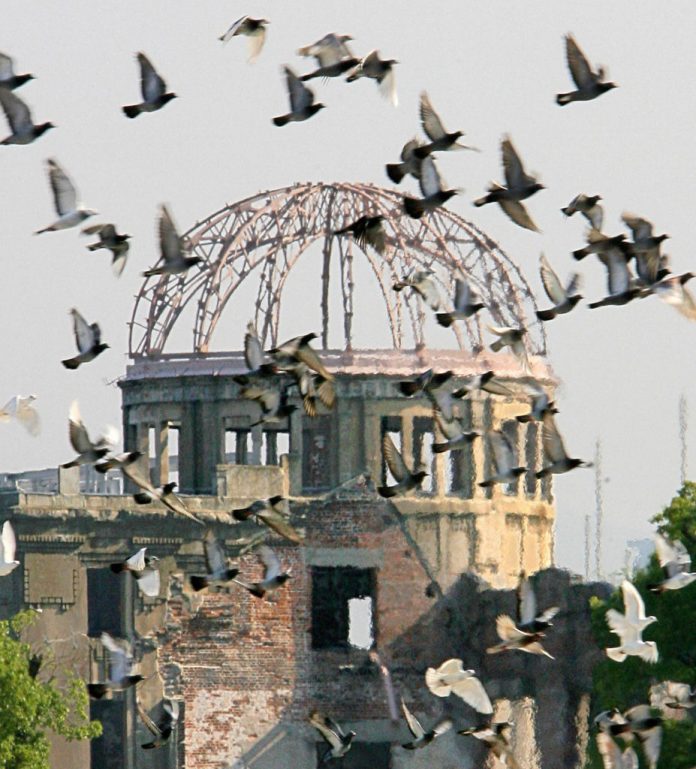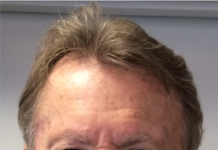Bill Simons
Three days after the 2000 US Open the Yonex racket company called me. They wanted me to come to Japan to interview Monica Seles, and be the first tennis writer to visit their plant. But if I was going all the way to Japan, I knew I had to visit one of the most poignant sites in the world. Now, on the 75th anniversary of the dropping of the atom bomb, I’d like to share what I found on my daunting visit to Hiroshima.
*****
It was just another morning – crystal clear, summer-warm—when Kimoke Uedo looked up. The air-raid alarm had sounded all-clear at 7:31 AM. But something was wrong. She soon heard the drone of an American B-29. She glanced to the sky as it exploded into an orange-red terror. A rolling thunder – fierce and frightening – pounded; a searing heat ripped her skin, melting her flesh.
The moment changed her life and the fate of our world. Death and despair have long been a staple, but never before had mass annihilation been unleashed in a matter of seconds. Over 200,000 would die; countless unborn children were damaged; a city was flattened – a wretched war ended. And with all this, at 8:15 AM on that warm morning, our innocence was lost – forever.
A Faustian deal had been struck. The genius of Einstein had led to the horror of Hiroshima. The nuclear genie danced with glee. We won the war – Hallelujah! But self-destruction, now and forever, would shadow us.
And the debate began: sages, philosophers and soldiers all asked daunting questions. What were President Truman’s options? Why not drop the bomb on a less populated target? Were nuclear arms simply an inevitable horror waiting to happen? Who among us was to blame? Worse yet, is there no one to blame at all? Haunting questions remain.
So, too, Hiroshima remains.
Rebuilt with vigor and courage, today it’s just another astoundingly ordinary port city – ships and shops. A bored teen reads her horoscope on the trolley. Toys’R’Us thrives.
But then again, nothing is ordinary in this town. As you approach it on the train, an orange sunset blazes, but the beauty is illusive. You think of another far different orange sky 55 years earlier. That first night in your hotel bar, an anonymous torch singer offers familiar tunes. But here, the well-worn classic “It’s a Wonderful World,” doesn’t ring true.
Similarly, at first glance, the grassy expanse where Hiroshima’s two rivers meet seems like just another city park. Girls in red caps chase pigeons; boys jostle and sprint and the homeless slumber on benches. From a nearby baseball stadium comes the incessant, intrusive blare of drums and trumpets. Here the beloved home team, the Hiroshima Carp, are struggling, some 14 games back in the Japanese Central League. Still, the PA insists, “We will, we will, rock you!” But that’s about all that’s ordinary here.
For Hiroshima’s Memorial Peace Park is a place apart. An almost sacred, seemingly immortal remembrance, it displays what must not be forgotten: the gruesome, almost unthinkable impact of atomic weaponry. All the while, it is an understated, elegant and brave call for peace; a kind of ground zero for those hoping to rid this world of nuclear armaments.
So the peace pilgrims come, peddling clunky old black bicycles or on shiny tour buses – a dazed Belgian nun, a couple of blunt Aussies, a wide-eyed Miami teacher toting the colorful peace cranes her students have carefully folded. And, of course, generations of Japanese descend – solemn and silent. Touched by sorrow, they enter the museum; faces drawn with reflection, tears flow, “How could this happen?” the unspoken question.
The museum details the horrific reality. Hiroshima was long a military hub for a brutal expansionist empire, a launching ground for Japan’s scorched-earth campaigns from Siberia to Burma, Manchuria, Korea and Gauadalcanal. Sprawling on a flat plain surrounded by mountains, Hiroshima hadn’t been bombed through the war. The military city was a perfect target.
And when the horror hit, darkness descended. The crackle of the flames silenced all the plaintive calls for help. Watches stopped, sewing needles were bent, tiles buckled, clothes were in tatters, lives were destroyed. In a tin factory a man was crushed by falling books. Thousands fled, clogging the rivers. For days, children wandered haplessly in a charred atomic desert. Few came to help – those who did suffered radiation exposure.
One man at the museum, Bill Hayden from Salem, Oregon, sadly noted, “This place puts it all in perspective. Yesterday I was stuck [due to an earthquake] on a train in a dark tunnel for four hours. I thought I had it bad; but forget it.” Denise Chapman, a Beaverbrook, Ohio teacher spoke of shame. “I was so embarrassed. I wanted to apologize to everyone in there. But, how do you? Maybe I’ll find a way.”
Outside the museum, many ring the peace bell, or place paper cranes on a children’s monument in honor of Sedako Sasaki, an Anne Frank-like heroine who folded 640 paper cranes in the futile belief that she might overcome the leukemia she had contracted.
A bit in a daze, visitors quietly take in one of the world’s most powerful sight lines. From a simple memorial tomb shaped like a traditional Japanese clay burial house (underneath which are the remains of 70,000 victims), the eye focuses on the solitary peace flame which will burn until nuclear weapons are banished. Finally, on the horizon beyond, is the haunting hulk of Hiroshima’s old Industrial Promotion building. Once considered one of the city’s avant garde structures, it is now a ghostly skeletal frame surrounded by piles of rubble that evoke unspeakable horror.
A journey to the Memorial Peace Park is revealing, daunting, exhausting. Somehow, too, it is an oddly uplifting epiphany – a testament to the power of nature, the depth of evil and our fierce instinct for survival and renewal.
Touched by the experience, I ring the peace bell and think of my family and the family of humanity, and Kimoke Uedo, who saw fire in the sky on a warm summer morning.



















